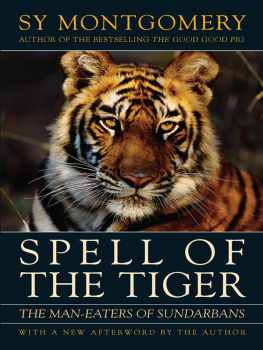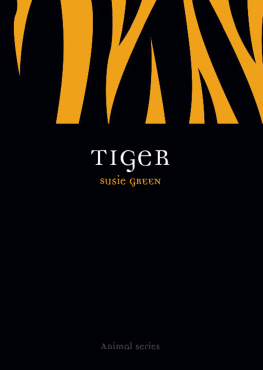THE SIBERIAN TIGER PROTECTION SOCIETY
In 1995, Sooyong Park, alongside Dr. Galina Salkina and Vladimir Kalesnikov from Lazo Nature Reserve, established the Siberian Tiger Protection Society ( STPS ) to protect and study wild Siberian tigers. Every year the STPS works to reduce poaching and trapping, prevents avoidable tiger deaths in villages, educates local villagers about tigers, and studies wild tigers in the field.
For further information on the STPS or to find out how to support our work, please write to:
SIBERIAN TIGER PROTECTION SOCIETY
111-401 Garam, 127 IL won-ro, Gangnam-gu
Seoul, Korea
tiger.hut2.ru
tigre1218@naver.com
Tel: 82-10-7302-1928
PRAISE FOR GREAT SOUL OF SIBERIA
Sooyongs magical prose led me into little-known and breathtakingly beautiful forests, exposed me to the bitter cold of long winter months, and revealed the secret life of that most mysterious of cats, the Siberian tiger.
JANE GOODALL, UN Messenger of Peace
A beautiful book, and the best account of Siberian tigers Ive read. Parks remarkable first-hand observations of a wild tiger family contain the wisdom of his years of experience and are written with great verve, intelligence, dedication, and understanding.
JEFFREY MASSON, author of Beasts: What Animals Can Teach Us About the Origins of Good and Evil
This book is an unbelievably gripping account of one mans laser-focused determination to find, film, and understand one of the rarest and most formidable cats on earth. Not only is Sooyong Parks story astonishingits also shared with such intense emotion that you feel youre right there with him.
CHRIS MORGAN, ecologist, host of Siberian Tiger Quest
An astonishingly intimate peek into a family of the greatest of cats, and a man in love with watching them. Sooyong Park has felt the breath of a wild Siberian tiger on his cheek, and so will you.
WILL STOLZENBURG, author of Where the Wild Things Were
One mans fascinating account of what its like to live in a frozen world most of us can barely imagine, in the presence of one of the most magnificent and mysterious animals on earth.
GEOFFREY C. WARD, author of Tiger-Wallahs and The Year of the Tiger
To read Great Soul of Siberia is to go deep into the tigers mysterious Russian realm with an expert guide. Thanks to author Sooyong Parks vivid prose, you will feel extremes of cold and fear, triumph and heartbreak. And you will be helpless against falling in love, as he did, with the tigers wild magnificence.
J.A. MILLS, author of Blood of the Tiger
A beautifully patient, deep-textured exploration of an unknown part of the world and its ancient guardian, the majestic Amur tiger, by a wonderfully empathetic naturalist.
RUTH PADEL, author of Tigers in Red Weather and Where the Serpent Lives
A triumph of nature writing; an original and authentic voice from the wilderness.
JONATHAN & ANGELA SCOTT, The Big Cat People
A courageous and eloquent adventurer, Park is truly a kindred spirit of the magnificent Siberian tiger, and a compassionate steward of its environment.
JEWEL PALOVAK, co-executive producer of Grizzly Man
GREAT SOUL OF SIBERIA
Passion, Obsession, and One Mans Quest for the Worlds Most Elusive Tiger
SOOYONG PARK
Foreword by JOHN VAILLANT
Copyright 2015 by Sooyong Park
Translation copyright 2015 Jamie Chang
Foreword copyright 2015 John Vaillant
Great Soul of Siberia is published under the support of the Literature Translation Institute of Korea ( LTI Korea).
All rights reserved. No part of this book may be reproduced, stored in a retrieval system or transmitted, in any form or by any means, without the prior written consent of the publisher or a license from The Canadian Copyright Licensing Agency (Access Copyright). For a copyright license, visit www.accesscopyright.ca or call toll free to 1-800-893-5777.
Greystone Books Ltd.
greystonebooks.com
Cataloguing data available from Library and Archives Canada
ISBN 978-1-77164-113-5 (cloth)
ISBN 978-1-77164-114-2 (epub)
Editing by Jennifer Croll
Copy editing by Lana Okerlund
Proofreading by Stefania Alexandru
Cover and text design by Nayeli Jimenez
Cover photograph by Andy Rouse/Getty Images
Maps by Eric Leinberger
Thank you to Vladimir Medvegev and Galina Salkina for providing some of the photographs, and to Sora Kim-Russell, who read and offered feedback on the translation.
We gratefully acknowledge the financial support of the Canada Council for the Arts, the British Columbia Arts Council, the Province of British Columbia through the Book Publishing Tax Credit, and the Government of Canada through the Canada Book Fund for our publishing activities.
PROLOGUE
SINCE 1995, IVE been researching and observing wild tigers in Manchuria, the North Korean border region, and Ussuri (officially known as Primorsky Krai), which together form the southeastern corner of Siberia. Ive spent half of each year wandering forests and climbing mountains in search of tracks and the other half in underground bunkers filming tigers in -30C weather. Twenty years of waiting for tigers that seldom come has been a frustrating and humbling experience, but ultimately a rewarding one that has yielded seven documentaries on Siberian tigers, including Siberian Tiger Quest. When I first began, there was less than an hours worth of wild Siberian tiger footage in the world, but twenty years later, Ive amassed close to one thousand hours of footage. The observations Ive made with my own eyes are three or four times the length of my recordings.
Blending into nature and staking out for long periods are no small undertakings. When Im confined to an underground bunker in the wild, I have to take care of everything in that space: go to the bathroom, melt frozen rice balls for meals, and brave the cold Siberian winds. After six months of not being able to shower, shout, or turn on the light, I begin to identify with prisoners in solitary confinement.
When a tiger appears after an interminable wait, its as if Im seeing the face of a lover Ive been dreaming of. My heart races as Im overwhelmed with joy, and time stretches on like eternity in those few brief seconds. Then, suddenly, joy is replaced by terror. The tiger notices something is out of place and heads straight toward me, its eyes burning blue in the dark. Footsteps approach, snow crunching under the tigers paws. The sound stops. I feel the tigers hot breath on my face. The fragile pendulum of existence swings between life and death before my eyes.
But in the end, it isnt the fear of my physical reality in the wildthe cold, the beastsbut an absolute sense of aloneness that freezes me to the bone in the bunker. As I tremble in the two-square-meter space like someone having an attack of claustrophobia, I realize that, unlike tigers, humans are a species meant to live alongside others.
There are five species of tigers on our planet: the Siberian tiger, the Bengal tiger, the Indochinese tiger, the Sumatran tiger, and the South China tiger. All except the Siberian tiger live in tropical regions. The Siberian tiger lives in Ussuri, Manchuria, and the Korean Peninsula. Russians call it the Amur tiger, and the Chinese call it the Northeast tiger (as opposed to the South China tiger). Theyre Manchurian tigers when spotted in Manchuria, Ussuri tigers when spotted in Ussuri, and Korean tigers when spotted in the Korean Peninsula, but they all belong to the same subspecies known as Panthera tigris altaica.
Siberian tigers are very reclusive compared to their tropical counterparts; they avoid contact with humans at all costs and live secretive lives in vast mountain ranges. Chancing upon a tiger in the woods is like finding a needle in a haystack. The luckiest tiger researchers get to see wild tigers maybe once or twice in their entire careers. Its no surprise, therefore, that a great part of the Siberian tigers behavior remains a mystery. Next to nothing is known about how tiger families are formed and dissolved, such as the behavior of females with cubs or the relationships between males and cubs. But when we do happen to see Siberian tigers in the wild, their talent for hiding, their wisdom to gauge the situation and know when to back off, and their bravery to fight to the end when they must are wondrous to observe.
Next page
















